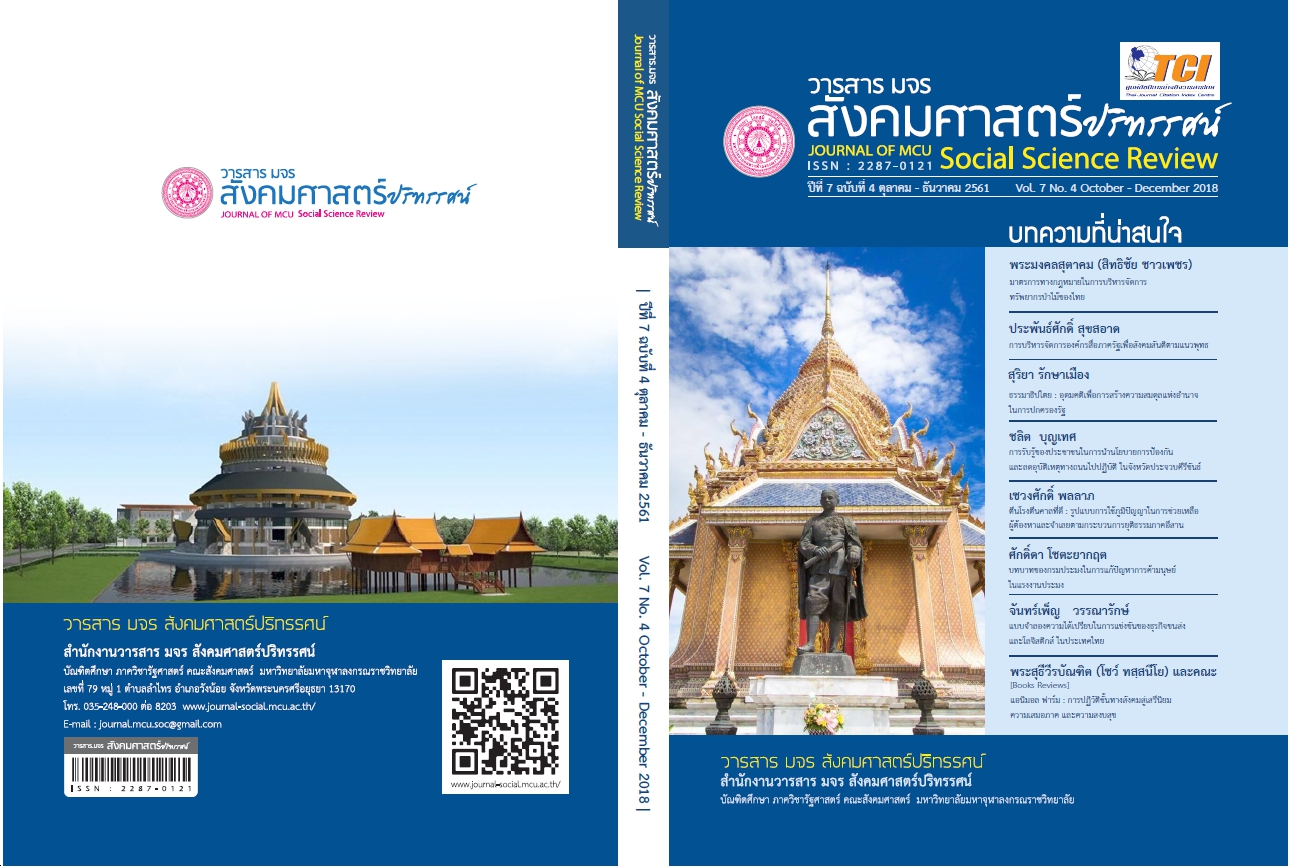คุณภาพชีวิตการทำงานของพนักงานบริษัทกลุ่มสวนอุตสาหกรรมโรจนะ จังหวัดพระนครศรีอยุธยา
คำสำคัญ:
คุณภาพชีวิตการทำงาน, พนักงาน, บริษัทสวนอุตสาหกรรมโรจนะบทคัดย่อ
บทความนี้มีวัตถุประสงค์เพื่อศึกษาระดับคุณภาพชีวิตการทำงานของพนักงานบริษัทกลุ่มสวนอุตสาหกรรมโรจนะ จังหวัดพระนครศรีอยุธยา ศึกษาปัจจัยที่เกี่ยวข้องกับการทำงานที่มีผลต่อระดับคุณภาพชีวิตการทำงานของพนักงานบริษัท และนำเสนอรูปแบบการพัฒนาคุณภาพชีวิตการทำงานของพนักงานบริษัทกลุ่มสวนอุตสาหกรรมโรจนะ จังหวัดพระนครศรีอยุธยา
ระเบียบวิจัยเป็นแบบผสานวิธีเชิงคุณภาพและปริมาณ กลุ่มตัวอย่างเป็นพนักงานบริษัทกลุ่มสวนอุตสาหกรรมโรจนะ จังหวัดพระนครศรีอยุธยา จำนวน 400 ราย เครื่องมือที่ใช้ในการวิจัยคือแบบสอบถามและการสัมภาษณ์เชิงลึก วิเคราะห์ข้อมูลด้วยค่าความถี่ ค่าเฉลี่ย และค่าส่วนเบี่ยงเบนมาตรฐาน และสถิติพรรณา การวิเคราะห์ความแปรปรวนทางเดียว (One-Way ANOVA) และ
ค่าสัมประสิทธ์สหสัมพันธ์แบบเพียร์สัน (Pearson Correlation)
ผลการวิจัยพบว่าระดับคุณภาพชีวิตการทำงานของพนักงาน โดยรวมอยู่ในระดับมาก ความผูกพันและความภาคภูมิใจต่อองค์กร มีค่าเฉลี่ยมากที่สุด ( = 3.52) รองลงมาคือการพัฒนาความรู้ความสามารถในการปฏิบัติงาน,ความปลอดภัยและสุขลักษณะ ( = 3.50) และน้อยที่สุดคือค่าตอบแทนที่เพียงพอและยุติธรรม ปัจจัยที่เกี่ยวข้องกับการทำงานภาพรวมอยู่ในระดับมาก ด้านความหลากหลายของงาน, แรงจูงใจในการทำงาน มีค่าเฉลี่ยมากที่สุด ( =3.58) รองลงมาคือด้านความมีอิสระในการทำงาน ( =3.56) และน้อยที่สุดคือการมีโอกาสรับรู้ผลการปฏิบัติงาน ( =3.38) การเปรียบเทียบระดับการศึกษาและการได้รับโอกาสในการปฏิบัติงานที่ท้าทายความรู้ความสามารถ พบว่าพนักงานที่มีการศึกษาระดับมัธยมปลายหรือ ปวช. และพนักงานที่มีการศึกษาระดับอนุปริญญาหรือปวส. มีการได้รับโอกาสในการปฏิบัติงานที่ท้าทายความรู้ความสามารถที่ต่างกัน (Sig. = 0.032) และพนักงานที่มีการศึกษาปริญญาตรี มีการได้รับโอกาสในการปฏิบัติงานที่ท้าทายความรู้ความสามารถที่ต่างกัน (Sig=0.000) ขณะที่พนักงานที่จบระดับอนุปริญญาหรือ ปวส. และพนักงานมีระดับการศึกษาปริญญาตรี ได้รับโอกาสในการปฏิบัติงานที่ท้าทายความรู้ความสามารถที่ต่างกัน (Sig.=0.015) รูปแบบการพัฒนาคุณภาพชีวิตการทำงานของพนักงานบริษัทพบว่าด้านค่าตอบแทนที่เพียงพอและยุติธรรม พนักงานได้รับค่าตอบแทนและสวัสดิการอื่น ๆ ที่เหมาะสมกับงาน ตลอดจนครอบครัวของพนักงาน ด้านความมั่นคงและโอกาสความก้าวหน้าในงาน พนักงานได้รับการทำสัญญาจ้างแบบถาวร เพื่อความมั่นคงต่อการทำงานและการได้รับสวัสดิการเท่าเทียมพนักงานประจำ สนับสนุนกิจกรรมของเส้นทางสายอาชีพ ความปลอดภัยและถูกสุขลักษณะ บริษัทเน้นความปลอดภัยระหว่างการปฏิบัติงาน ข้อปฏิบัติงานและมาตรฐานการทำงาน กิจกรรมส่งเสริมสุขภาพจิตและกายที่ดี มีสวัสดิการด้านสุขภาพ ความมีระเบียบกฎเกณฑ์ในการทำงาน บริษัทต้องกำหนดนโยบายการปรับทัศนคติของพนักงาน สร้างพนักงานให้เป็นคนเก่งและคนดีของบริษัท
เอกสารอ้างอิง
Chonnakan Muanthap and Janchalee Maphut. (2008). The Factors Influencing
Work Life Quality of Industrial Workers in Prapradang District Samutprkarn Province. Faculty of Education Burapha University.
Journal of Education and Social Development, 4(2),1.
Huse, E.F., and Cummings T.G. (1985). Organization Development and Change.
3 rd ed. Minnerota : West Publishing.
Issaraporn Rattanakhod. (2008). The Relationship Between Demographic Factors and Quality of Working of Life and Organization Commitment off Supporting Staff at Prince of Songkla University. Pattani Campus. Songkla University.
Jiraporn Rahothan. (2013). Quality of Life of Workers in Eastern Area of Thailand : Chonburi, Rayong, Chanthaburi, and Trat Provinces. Master of Business Administration in Graduate School, Sripatum University Chonburi Campus.
Kangwan Yodwisitsak. (2014) . Building up Employee Engagement through Happy Workplace Concept in Gen-Y Employees. wms Journal of Management, 3(2),1-10.
ดาวน์โหลด
เผยแพร่แล้ว
รูปแบบการอ้างอิง
ฉบับ
ประเภทบทความ
สัญญาอนุญาต
ลิขสิทธิ์ (c) 2019 วารสาร มจร สังคมศาสตร์ปริทรรศน์

อนุญาตภายใต้เงื่อนไข Creative Commons Attribution-NonCommercial-NoDerivatives 4.0 International License.
เพื่อให้เป็นไปตามกฎหมายลิขสิทธิ์ ผู้นิพนธ์ทุกท่านต้องลงลายมือชื่อในแบบฟอร์มใบมอบลิขสิทธิ์บทความให้แก่วารสารฯ พร้อมกับบทความต้นฉบับที่ได้แก้ไขครั้งสุดท้าย นอกจากนี้ ผู้นิพนธ์ทุกท่านต้องยืนยันว่าบทความต้นฉบับที่ส่งมาตีพิมพ์นั้น ได้ส่งมาตีพิมพ์เฉพาะในวารสาร มจร สังคมศาสตร์ปริทรรศน์ เพียงแห่งเดียวเท่านั้น หากมีการใช้ภาพหรือตารางหรือเนื้อหาอื่นๆ ของผู้นิพนธ์อื่นที่ปรากฏในสิ่งตีพิมพ์อื่นมาแล้ว ผู้นิพนธ์ต้องขออนุญาตเจ้าของลิขสิทธิ์ก่อน พร้อมทั้งแสดงหนังสือที่ได้รับการยินยอมต่อบรรณาธิการ ก่อนที่บทความจะได้รับการตีพิมพ์ หากไม่เป็นไปตามข้อกำหนดเบื้องต้น ทางวารสารจะถอดบทความของท่านออกโดยไม่มีข้อยกเว้นใดๆ ทั้งสิ้น





